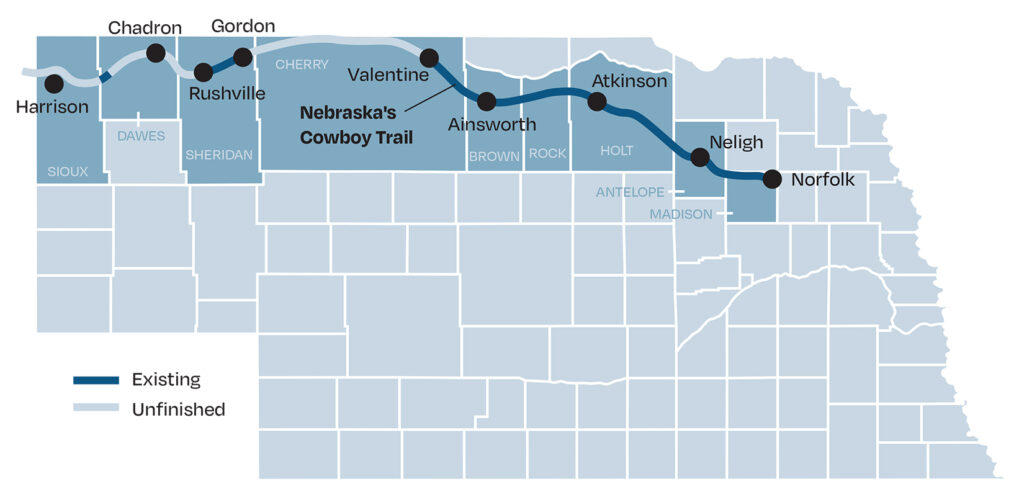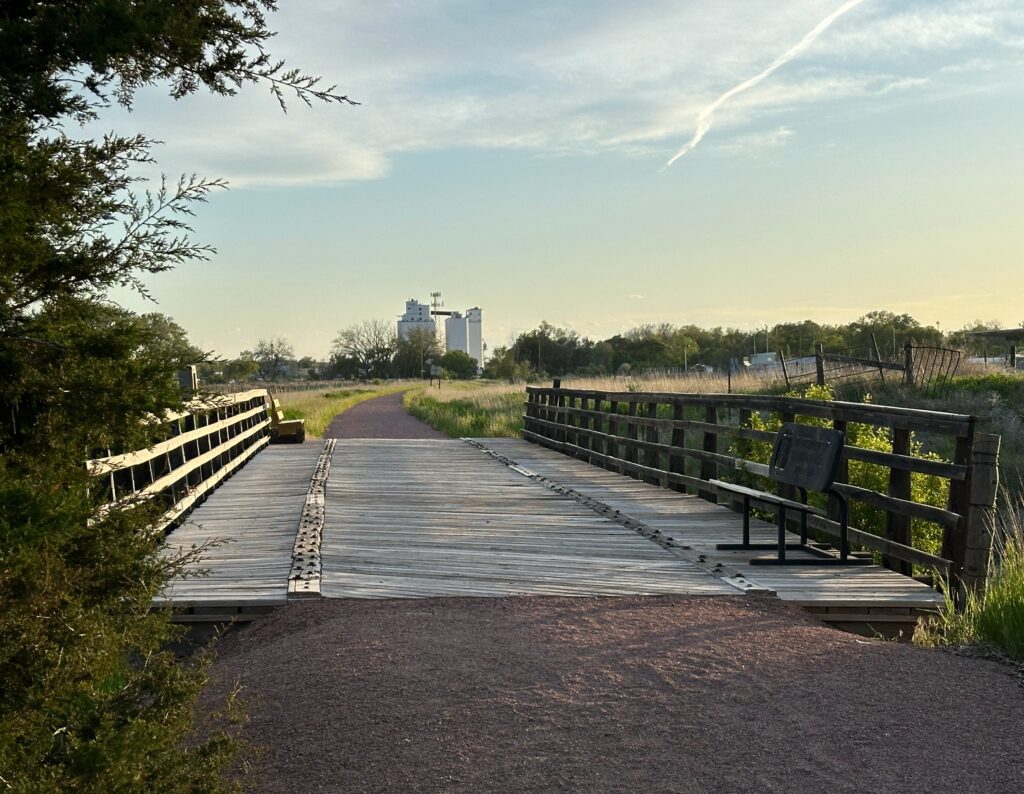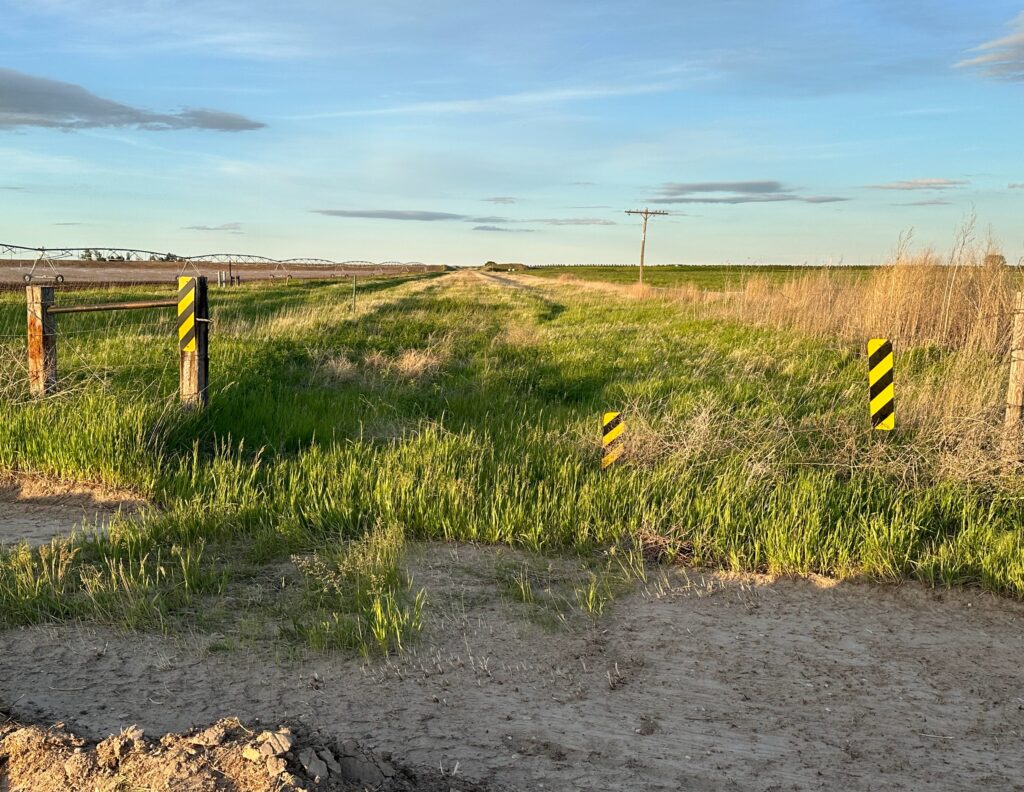Kris Ferguson had a quick reply when someone asked how she and a small group of volunteers managed to finish a 17-mile stretch of the long-planned but unfinished Cowboy Trail in northwest Nebraska.
“Oh it’s easy,” Ferguson responded. “You just need someone who’s willing to go out and get hit by a car while riding their bike.”
Ferguson, of Gordon, credits a 2011 crash with spurring her activism. It also left her with a broken leg, broken arm, bruised lung, severe whiplash, a concussion and a hip that wasn’t broken but definitely wasn’t right.
“I was riding my bike on the narrow shoulder of the highway outside of Gordon when an inattentive driver sideswiped me. They didn’t hit me with the front of their car, which is why I think I’m alive today,” she recalled. “That and a guardian angel.”
The campaign to complete that 17-mile segment between Gordon and Rushville started roughly 20 years after a now-defunct railroad sold about 320 miles of abandoned rail stretching across northern Nebraska from Norfolk to Chadron. The idea was to convert the line into a trail for hiking and biking.
Dubbed the Cowboy Trail, the first 187 miles, from Norfolk to Valentine, came on line within 15 years. Then, nothing.
Now 30 years later, about 90 miles remain incomplete. Several miles aren’t even clear enough of weeds to walk on, let alone ride a bicycle. Despite the agonizingly slow pace, trail proponents say they are making progress.
With grant funding, groups are working together to finish another chunk of the trail near Chadron. After years of skepticism and setbacks, there is momentum, they say.
But even the most ardent boosters acknowledge: It’s going to take a lot more time and resources to finally finish the Cowboy Trail.
“Well, someday maybe,” said Nebraska Game and Parks recreational trails manager Alex Duryea when asked whether the trail will be completed. “It would be a long road to get there.”
Barreling by early adversity
When the old Chicago and North Western Railroad moved to abandon more than 300 miles of Nebraska-traversing rail in the early ‘90s, trail advocates sensed an opportunity.
Building off federal legislation from a decade earlier, Nebraska lawmakers passed a bill in 1993 allowing the state to take ownership of the abandoned line. It also established the “Cowboy Trail” name.
Later that year the Rails to Trails Conservancy, a national nonprofit created to transform old rail lines into trails, helped negotiate a deal with the state and the railroad. The conservancy purchased a portion of the line for about $6.2 million and donated it to the state, according to news reports.
A leading advocate for the project, the late Don Van Driest, told the Lincoln Journal Star that he anticipated it would take eight to 10 years to complete the entire project.
Even before agreements were finalized, some were touting the Cowboy Trail’s economic promise – a habit that holds true now more than 30 years later.
Once finished, the Cowboy Trail will be the largest rail-to-trail project in the U.S., eventually becoming part of the nation-crossing Great American Rail-Trail.
The Cowboy Trail’s inclusion in the Great American Rail-Trail could translate to nearly 2 million trips and about $14.5 million in annual visitor spending in Nebraska, said Kevin Belle, the Great American’s project manager at the Rails to Trails Conservancy.
“And in a state like Nebraska, where there’s a lot of small towns that rail can go through, it can have a huge impact,” Belle said.
The Cowboy Trail ran into obstacles from the start. There were legal challenges and concerns about runaway costs.
Opponents, including nearby landowners, fought it on multiple fronts. They pointed to a provision requiring Game and Parks to construct and maintain special livestock fences along the trail – a move that was seen as an attempt to make the project cost prohibitive. The ordeal forced the Legislature to pass a bill defusing the fencing issue.
More than 100 miles of trail were open within a decade of the state taking ownership of the abandoned line. Despite budget cuts and other setbacks, Game and Parks completed work between Norfolk and Valentine in 2008, The World-Herald reported.
Flooding caused major damage to parts of the existing trail in 2010 and seemingly washed away any chances of further expansion west of Valentine.
‘It’s dangerous’
Ferguson’s wreck in 2011 left her frustrated. “I couldn’t do anything that summer, but I had one good hand and my mouth worked.”
She got on the phone and began calling Nebraska Game and Parks.
“It’s dangerous for people in our area to get out and try to be active. When are you going to complete the trail? And the answer I got was ‘never,’” Ferguson recalled. She didn’t like that answer.
Ferguson formed a nonprofit, Cowboy Trail West, and started organizing. The group held meetings and attended Game and Parks meetings, proving to be relentless. They got involved with the Nebraska Trails Foundation in Lincoln, which helped with their lobbying efforts.
Neighbors in both Gordon and Rushville got involved. They donated time and supplies and raised tens of thousands of matching dollars to help secure larger grants.

The entire 17-mile trail segment opened in 2019, eight years after Ferguson was hit by a car while riding her bike along a highway.
“The only way we got it going from Gordon to Rushville was that they said if you guys will maintain it, we will help you try to get it done,” said Ross Elwood of Rushville, president of the Cowboy Trail West board. “So we’re doing our part to maintain it out here.”
The success between Gordon and Rushville inspired trail enthusiasts in Chadron, the western bookend of the Cowboy Trail. They formed their own nonprofit in 2017, the Northwest Nebraska Trails Association.
Much like the Gordon-Rushville group, the folks in Chadron have hit hurdles, including skepticism from some community leaders.
“When our group formed, everyone told us, ‘You know, don’t make it a priority. It’s never going to get done,’” said Brittany Helmbrecht, president of the Northwest Nebraska Trails Association in Chadron.
The doubt extended to the Nebraska Game and Parks Commission, where some members remarked that they never saw any people on the existing trail, Helmbrecht recalled. Then at an August 2023 meeting, commissioners heard an update about usage numbers. (Duryea with Game and Parks said counters tracked 80,000 users on the trail in 2023.)
(Correction: This paragraph named the incorrect commission. It was the Game and Parks Commission, not the local county board of commissioners.)

“And after that, one of the commissioners who said in the past that this will never get done, actually came up to us and he said, ‘if we don’t get the Cowboy Trail done, I think we’re really going to regret it.’ And the other commissioners next to him reached over and checked his temperature, because he was the same one who had said, ‘no, this is a waste of money,’” Helmbrecht said.
Game and Parks secured a grant to develop the 26-mile stretch from Chadron to Rushville, but it ended up only covering bridge development, Duryea said. They applied for and got a grant through the Nebraska Department of Transportation to surface the trail segment. Game and Parks just hired consultants, Duryea said.
The Chadron-based group also is working on a new connector rail-trail that will bring the Cowboy Trail – which will actually end 5 miles east of Chadron – into town. Game and Parks awarded the city of Chadron a $178,540 grant in 2022 for the first phase of the connector project.
“It doesn’t do any good for the trail to end out in the middle of the field there,” said George Ledbetter, Northwest Nebraska Trails Association’s treasurer.
‘Don’t hold your breath’
Even once the work near Chadron is complete, roughly 88 miles of trail will remain undeveloped between Valentine and Gordon.
Finishing it will undoubtedly be a heavy lift. It took about eight years to marshal support for and then complete the 17 miles between Gordon and Rushville. And even though Game and Parks has secured grant funding for the Rushville-to-Chadron segment, it will still take some time to finish the work on those 26 miles, especially since some of the funding is from the federal government.
“We’ve been told, don’t hold your breath on the surfacing happening anytime soon,” Helmbrecht said.
Game and Parks doesn’t appear to have any plans for finishing the missing link, which essentially exists as a natural area for wildlife.
It takes a lot of planning, effort and money to transform abandoned stretches of railroad into a safe and inviting trail, said Duryea. The real difference maker is the local community partners – groups like Cowboy Trail West and the Northwest Nebraska Trails Association.

“I mean, it’s possible,” Duryea said of the chances of completing the Cowboy Trail. “When you have a local group that supports the effort and the cities on board that are along there and all, that’s the spark that needs to happen for development to occur, in my experience anyways.”
In 2022, four Nebraska nonprofits, including Cowboy Trail West and the Northwest Nebraska Trails Association, announced they were forming the Cowboy Trail Coalition to advocate completing the trail.
Once the Chadron-to-Rushville chunk is done, the groups plan to turn to the stretch between Valentine to Merriman, said Elwood with Cowboy Trail West. Then they will be down to one final unfinished segment between Merriman and Gordon.
Helmbrecht with the Chadron group remains hopeful.
“I think, you know, we see all these trails on the east side of the state, and how successful they are. And then post COVID, we saw how much bicycle usage went up. I think now it’s kind of just a matter of time.”
Now 30 years down the road, Elwood and others want to make sure this end of the trail continues to inch forward, at hopefully an increasing rate of speed.
“We’ve got a lot invested in our trail … and we don’t want to see it go south on us.”



8 Comments
Last June I rode the Cowboy Trail from Bassett to Valentine. The trail was wiped out just before Long Pine. That was a very unpleasant surprise. It looked like a derecho or flood wiped out a levee. I had to find my way to Long Pine on the back road to get back on the trail. The trail is like sand. I only saw 3 other bikers and that was just a mile from the Valentine bridge. Nobody else was on the trail for 60+miles. A few days later I rode the Mickelson Trail in the Black Hills. That’s how it should be done. I just rode the Wabash from start to finish in Iowa. Thats a great example of towns proudly protecting the trail. The Cowboy Trail has unique prairie and sandhills vistas that last forever (you seem to be getting nowhere) I should be a prairie lovers dream ride. But It desperately needs local support. And there are few towns on the trail. The focus should not be on it’s length, but rather it’s condition and safety. Check the weather..and expect it to change on long rides. It’s flat, but not for the light hearted. I will say it’s a great challenge with incredible potential. It would have been one heck of a train ride.
The Cowboy Trail would be much more popular if it were opened up to horseback riding and horse pulled wagons. Imagine creating a “Wagon Train ” to traverse the Cowboy trail.
I think that would be a great tourist attraction. I know that I would be willing to pay for a ride in a horse pulled wagon.
Game and Parks is just a political system and good ole boy club. A park named after a child pedofile is their golden goose. Many of their ” projects” never get finished within a generation. The governor needs to drain that swamp.
I have cycled at least 1/2 the trail and except for the miles from Norfolk to Neligh the trail was not a good experience. It has not been engineered correctly with the base or limestone top. If it rains, it is impossible to cycle. Then for some reason sand was dumped on portions of the trail. It is very deep red sand. Impossible! It looks like any leftover sand, gravel or dirt was just dumped on the trail.
It could be such a wonderful economic boost for the towns along the trail.
I also have cycled the Katy Trail, the Mickelson Trail, the Paul Bunyan in MN and the awesome Chief Standing Bear Trail. These trails are so outstanding and were built correctly with a great limestone surface. Even in the rain they are easy to bike on.
How come the Cowboy Trail can’t meet these standards?
I and others want rail service restored. The monopolists behind wrecking it need to be exposed. Loss of rail service means $20 million in higher road costs per year. Plus, the RR paid taxes–property and other.
As a person who has travelled Hwy 20 many, many times over many years, I can attest to the lack of walkers or riders on the ‘Cowboy Trail’. It is vacant most of the time and will never come minutely close to paying for itself. What else could these monies be spent on? How about our state campground roads?? The roads ( and I use this term loosely ) at Box Butte Rec Area near Hemingford are probably the worst in the state. ‘Nuff said.
Remember when the end all was to be the $5 Park permit, G&P leaves a lot to be desired besides the Mahoney